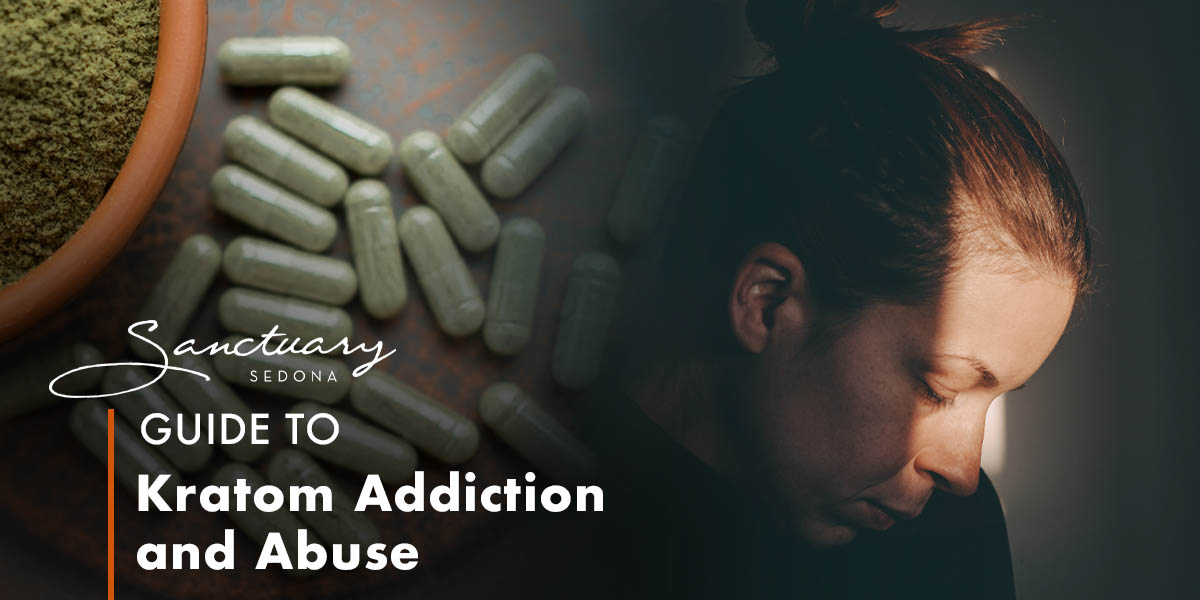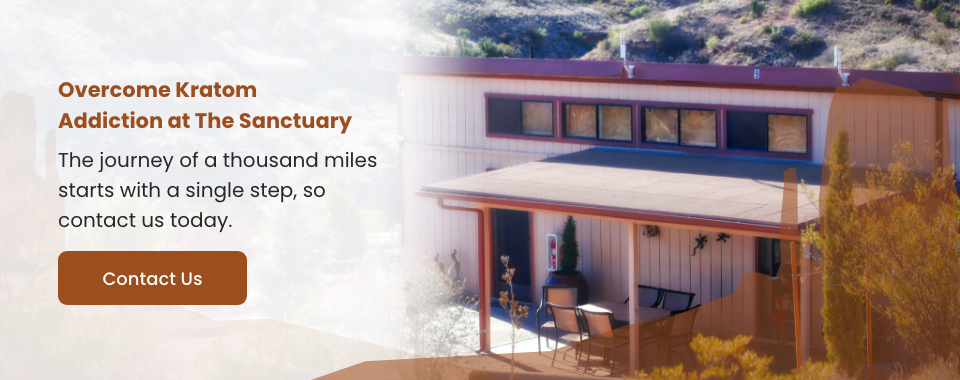Addiction is a thief. It robs people of an ordinary life and even takes their life altogether. Addiction, if untreated, can bring irreparable harm to the addicted and their loved ones, but there’s good news — it can be treated. Intervening for yourself or on behalf of someone is an incredibly brave step.
Our staff at The Sanctuary at Sedona is here to support you! If you’re concerned that you or someone you know may be snared by a kratom addiction, you’re not alone. Though addiction recovery is difficult, it is possible and we want to help.
The first step in addressing any addiction is understanding the substance that’s being abused. We’re going to take a look at kratom, how it’s misused, and the effects of abusing it. Then we’ll answer some of your most pressing questions and take a look at how you or someone you love can get the help they need to beat kratom addiction for good!
Kratom Addiction and Abuse
Mitragyna speciosa, commonly known as kratom, is a tropical tree indigenous to Southeast Asia, the Philippines and New Guinea. The communities in these regions traditionally used kratom leaves to alleviate fatigue and improve productivity. Laborers would either chew the leaves or brew them in a tea in order to combat weariness. It was also used in some religious practices or for medicinal purposes.
Though these communities have used kratom for at least 150 years, its recognition in the West is recent, which means that kratom is still being studied by scientists to fully understand its chemistry and effects. Still, alternative medicine and the supplement industry has gained such traction in the United States that ancient herbal remedies and treatments are actively sought after and exported from Eastern countries. Kratom is one of these herbs.
The effects of kratom depend largely on the dose. In small quantities, it has a stimulating effect similar to cocaine or amphetamines. In larger amounts, however, the effect is more sedative and more closely resembles an opioid. The alkaloid behind this effect is mitragynine, which can have mind-altering effects when ingested.
Kratom was popularized as a pain-killer, though many users started to use it in small doses as a recreational stimulant. It increased in popularity when misleading marketing and the Internet touted it as a holistic, natural pain medication — or as a lesser evil for opiates. Since herbal remedies are largely unregulated in the West, kratom distribution and dosage went largely unnoticed. That is until unrestricted access led to overdosing and addiction.
Why Is Kratom So Addictive?
The reason kratom becomes addictive is that mitragynine attaches easily to the opioid centers of the brain, which release the happiness-inducing hormone dopamine. Dopamine receptors allow us to feel pleasure and satisfaction, such as when we eat a good meal, have sex or listen to a favorite song. It’s the reward center of the brain that triggers us to repeat behaviors that are positive for us.
Opiates, or substances that act on your opioid receptors, flood the brain with too much dopamine at one time, causing the person to feel such an extreme sense of pleasure that they become very driven to repeat the sensation by experiencing that excessive dopamine release again. That’s what makes opiates such as morphine and heroin so addictive.
The same thing happens when people use kratom, especially in large doses. One study demonstrated that 80% of kratom users were unable to stop using kratom without intervention after six months, while half of them experienced an opiate withdrawal after they stopped using it. Kratom is popular as an opiate substitute to help opioid users curb their addiction to dangerous drugs such as heroin. The problem, however, is that kratom can still act on your opioid centers and cause recreational users to suffer from addiction.
Surprisingly, kratom is not a controlled substance in the United States, despite the fact that it’s been banned in Thailand since 1943 and is regulated in countries such as Myanmar, Malaysa, Australia and Bhutun. This is why it can be so dangerous — it’s accessible and legal to consume. The U.S. Food and Drug Administration (FDA) did issue a warning in 2019 about kratom use and advises against it. It remains to be seen if kratom will become a controlled or banned substance in U.S.
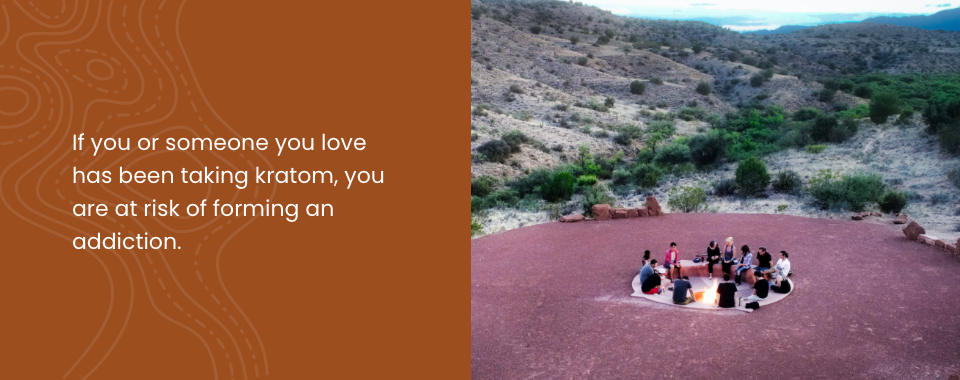
Signs and Symptoms of Kratom Abuse
If you or someone you love has been taking kratom, you are at risk of forming an addiction. You may even have one and won’t realize it until you try and stop. If you’re concerned about whether your kratom abuse is getting out of your control, take some time to reflect on your life and the way things have been going.
Read through the following signs you have kratom addiction and see if any match up with your life. Here’s how to tell if you may be addicted to kratom:
Behavioral Symptoms
- Being excessively chatty or talkative
- Exhibiting unpredictable behaviors that may be violent or aggressive
- Shirking personal responsibilities in relation to kratom abuse
- Choosing kratom use over activities you used to enjoy
- Spending inordinate amounts of time trying to acquire, use or recover from kratom misuse.
- Weepiness, crying easily or crying for an unknown reason
- Trying and failing to stop your use of kratom
- Continuing to use kratom despite the problems it causes you
- Continuing to use higher and higher doses and over longer periods than you wanted
- Continuing to use kratom when it is hurting your health to do so
- Wanting to quit using kratom but being unable to
Physical Symptoms
- Breathing trouble
- Constipation
- Inability to experience any pain
- Spiked energy in smaller doses
- Nausea and vomiting
- Sweating
- Dry mouth
- Drowsiness in larger doses
- Tremors or shakes
- Sleep problems
- Unexpected weight gain or weight loss
- Seizures
Mental Symptoms
- Uncontrollable kratom cravings
- Decreased libido
- Delusions
- Trouble concentrating after large doses
- Hallucinations
- Hyper-focus while working
- Hyper-vigilance
- Panic
Emotional Symptoms
- Nervousness
- Anxiety
- Depression
- Emotional detachment
- Emotional outbursts
- Irritability
- Moodiness
If you find that many of these symptoms mirror your current situation, it may be time to seek professional help.
Effects of Kratom Abuse
Kratom abuse can cause many negative effects on a person’s body and on their quality of life. The severity of these side effects will depend largely on the dosage and duration of abuse. What makes kratom’s effect on the body so complex is that individuals may have different tolerances — the same dose can manifest very differently in two separate individuals. Regardless, kratom can compromise any user and set the stage for addiction.
Short-Term Effects of Kratom
Kratom behaves differently in different dosages — low doses, or one to five grams of raw leaves, produce a stimulating effect that starts 10 minutes after ingestion and lasts anywhere from two to five hours. Larger doses, or five to 15 grams of raw leaves, are sedating and mirror the pain-relieving effects of opioid drugs. Whether the short-term use is in a low dosage, which is more likely, or in a high dosage, here are some common short-term effects:
- Nausea
- Itching
- Sweating
- Dry mouth
- Constipation or diarrhea
- Increased urination
- Loss of appetite
- Feeling agitated, irritable or uneasy
- Drowsiness
- Racing heart
- Poor muscle coordination in the arms or legs
- Hallucinations
- Seizures
- Liver damage
Even when used in the short term, users may find kratom hard to quit without professional help.
Long-Term Effects of Kratom
Based on research conducted on high-dosage kratom users in Thailand and Malaysia, several unusual long-term effects that can occur are hyperpigmentation on the face, extreme weight loss and psychosis. The effects that addiction has on a user’s body, lifestyle and well-being are significant. Some of these long-term difficulties may include:
- Divorce and losing custody of a child
- Job loss and perpetual unemployment
- Decreased productivity and job retention
- Gastrointestinal problems
- Legal troubles based on poor decision-making
- Exacerbation or onset of mental health disorders
- Progression to abuse other substances
- Respiratory problems
- Low libido or sexual dysfunction
Kratom abuse, like many other forms of drug addiction, can severely diminish a healthy and meaningful life if it’s allowed to continue untreated.
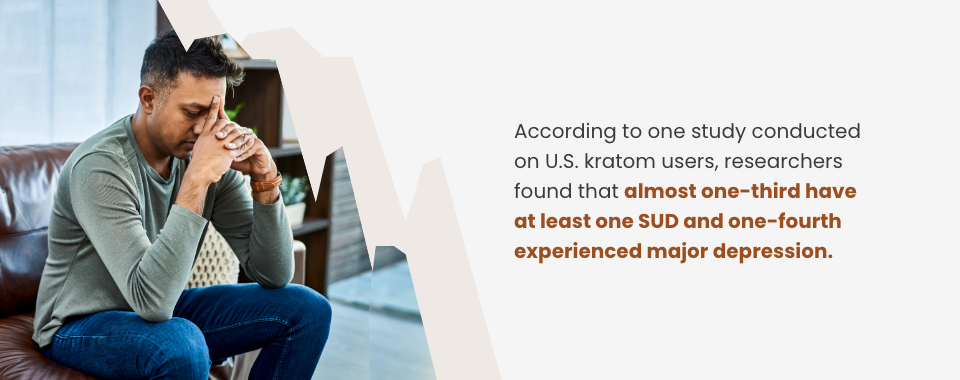
Kratom and Co-Occurring Disorders
When seeking treatment for kratom abuse, it’s important to understand that you may need to be assessed for co-occuring disorders. Sometimes, kratom abuse lives in tandem with conditions that are simmering beneath the surface, or even exasperating the addiction. Some of these corresponding conditions include:
- Depressive disorders
- Anxiety or panic disorders
- Substance use disorders (SUDs)
According to one study conducted on U.S. kratom users, researchers found that almost one-third have at least one SUD and one-fourth experienced major depression. One thing the researchers were quick to point out was that the data didn’t indicate that kratom itself was responsible for additional SUDs. So though it’s not uncommon for kratom users to abuse additional substances, their kratom use was not responsible for using another drug.
Even so, tackling additional problems alongside kratom misuse may feel overwhelming or intimidating, but don’t let that get in the way of seeking care. Addressing co-occuring disorders is all part of the road to full and complete healing.
Frequently Asked Questions (FAQs)
Let’s answer some of the most frequently asked questions about kratom use, addiction and recovery.
1. Can You Overdose on Kratom?
Yes, kratom overdoses happen, though most of the documented cases indicate that other substances tend to be involved. A report released by the Centers for Disease Control and Prevention (CDC) noted that 91 people died from kratom overdoses across 27 states between 2016-2017, though 84 of those cases involved substances like benzodiazepines, fentanyl and cocaine.
2. What Symptoms Are Associated With Kratom Withdrawl?
If you attempt to stop using kratom and notice the following symptoms, you may be experiencing kratom withdrawal:
- Depression
- Diarrhea
- Irritability
- Mood swings
- Muscle pains
- Panic
- Restlessness
- Runny nose
- Weepiness
Experiencing these withdrawal symptoms may be a sign that your body developed a tolerance for kratom. Withdrawal tends to be a tell-tale signal to seek out professional help.
3. Can You Recover From a Kratom Addiction?
Yes, you can! There is hope for anyone who is trapped by kratom addiction. With proper professional treatment, you can recover a sober lifestyle. Even if you’ve tried a recovery program and relapsed, it’s still possible to find freedom from addiction. If one treatment plan doesn’t work for you, there are still other scientifically-backed treatments that may help you beat kratom once and for all. Be gentle with yourself, and find the help that meets your individual needs.
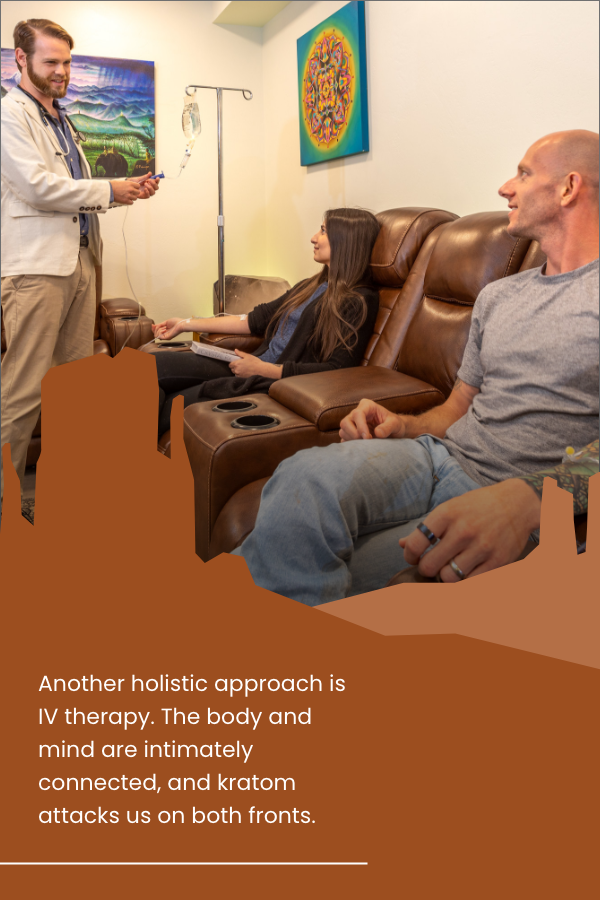
4. What Treatments Are Available?
There are many treatments available for kratom abuse, though there is no one treatment-fits-all available for recovery. Luckily, there are some recent, scientifically-backed and holistic options that are becoming more and more popular.
One option is a Non-12 Step Treatment program. Unlike 12 Step programs, such as Alcoholics Anonymous (AA) or Narcotics Anonymous (NA), which tend to focus on the behaviors of addiction, a Non-12 Step program works toward addressing the underlying roots of addiction. It also can be tailored to meet an individual’s preferences and needs without prescribing to one all-encompassing protocol.
Another holistic approach is IV therapy. The body and mind are intimately connected, and kratom attacks us on both fronts. To combat the mental struggles related to addiction, cognitive-behavioral and other types of therapies can be effective, but they see even more success when the body is prepared to embody the behavioral changes taking place. An intravenous infusion of essential vitamins and minerals is just the thing to empower the body as well as the mind to apply therapeutic remedies. There are several varieties of IV therapy, such as Ketamine Assisted Therapy, NAD+ and Vitamin IV Therapy.
Don’t settle when it comes to your treatment. Seek out professionals and facilities that are supportive and ready to accommodate your unique needs and goals for treatment. You should always be treated with dignity and respect throughout the process of your recovery. Remember, never be afraid to advocate for yourself.
Overcome Kratom Addiction at The Sanctuary
At the Sanctuary in Sedona, we believe in the power of holistic healing. We don’t consider our graduates to be in recovery but actually recovered. That’s because our 30-day residential recovery program is designed to meet individuals where they are and tailor a scientifically-backed treatment plan just for them.
Located in Sedona, Arizona, our facility is situated on a lovely and secluded 22-acre campus designed to be a safe haven for your healing process using our non-12 step therapeutic techniques. We designed it to be a true sanctuary where you can experience renewed hope.
The journey of a thousand miles starts with a single step, so contact us today. Our admissions team is ready to answer any questions you may have and to ensure you have everything you need to begin. We’ll be with you every step of the way.
Dr. Forrest is a licensed Naturopathic Physician specializing in retreat-style holistic medicine, natural detoxification and cleansing, mind/body medicine, and regenerative medicine. Dr. Forrest brings to his work a sense of humility, respect, and compassion that is too often absent in the sterile, rigid world of modern medicine. He is deeply honored and grateful to be continuing this work as part of the community and healing that is taking place at the Sanctuary. [email protected]
Check out other relevant articles:

